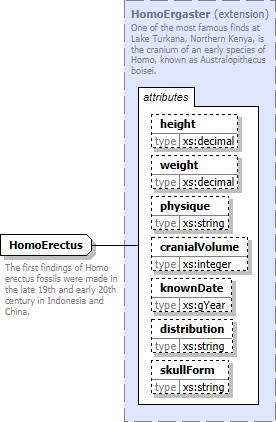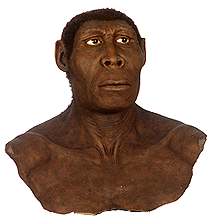
|
||||||||||||||
Namespace: |
http://www.geocities.com/palaeoanthropology |
Content: |
empty, 7 attributes |
Defined: |
globally in HumanEvolution.xsd; see XML source |
Used: |
never |

XML Representation Summary |
||||||||||||||||||||||
<... |
||||||||||||||||||||||
|
||||||||||||||||||||||
/> |
||||||||||||||||||||||
 The first findings of Homo erectus fossils were made in the late 19th and early 20th century in
Indonesia and China.
At first, these findings were not recognised as early hominids, but with later studies
it was finally accepted that Homo erectus was a widespread early human species.
The first findings of Homo erectus fossils were made in the late 19th and early 20th century in
Indonesia and China.
At first, these findings were not recognised as early hominids, but with later studies
it was finally accepted that Homo erectus was a widespread early human species.
Since the 1950s, discoveries of Homo erectus fossils have been made sporadically, principally in Africa, but also in Asia. The first of these discoveries took place in Algeria, where three jaws, a cranial bone, and some teeth were found. Several specimens of Homo erectus were also found at Olduvai Gorge, in East Africa, including a rather robustly built, large-brained cranium. Findings were also made in South Africa.
However, the richest source of fossils has been the Lake Turkana region of northern Kenya, both on the east and west sides. These sites have exposed the oldest and most complete speciments. In 1975, an almost complete cranium was found and then dated at 1.8 million years with a brain size of 880 cm³. A decade later, they found the now famous "Turkana Boy" which is renowned for its almost complete skeleton. This skeleton was a huge aid in assessing overal body proportions and relationships of the species. This boy stood more than 5 feet tall when he died, and would have exceeded 6 feet – had he lived to maturity. His cranial capacity was 880 cm³ and his body stature (tall, thin, long arms and legs) are typical of humans adapted to open, tropical environments.
Two different hypotheses exist stating where Homo erectus first arose. The first model is called The Multiregional Evolution Model and used to be by far the most popular until recent genetic evidence was brought to light by a scientist at the University of California at Berkeley called Allan Wilson. This model believes that roughly 1 million years ago, Homo erectus expanded its range beyond Africa, first into Asia and then into Europe, developing geographically variable populations. Homo erectus then became the direct ancestor of Homo sapiens by a gradual worldwide (excluding the Americas and Australia) evolutionary transformation of all populations of Homo erectus.
The second hypothesis is referred to as the "Out of Africa Model" and believes that that it was not a gradual worldwide change that led to the evolutionary transformation of populations of Homo erectus, but a speciation event in a single population in Africa, which then spread throughout the Old World and replaced established populations. This hypothesis was brought forward by Allan Wilson who in 1987 proved with genetic evidence that all modern humans evolved from a single female who lived in Africa approximately 200,000 years ago. This is also known as the "Mitochondrial Eve Hypothesis".
| Height | 1.3 – 1.7 metres |
| Physique | Robust, but "human" skeleton |
| Cranial Volume | 750 – 1250 cm³ |
| Known Date | 1.8 – 0.1 million years ago |
| Distribution | Africa, Asia and Indonesia (and Europe?) |
| Skull form | Flat, thick skull with large occipital and brow ridge |
| Jaws/Teeth | Robust jaw in larger individuals; smaller teeth than H. habilis |
|
Type Derivation Tree
ArdipithecusRamidus (extension)
|
|
</xs:complexType>
|
Type: |
xs:integer, predefined
|
Use: |
optional |
Defined: |
locally within ArdipithecusRamidus complexType
|
Type: |
xs:string, predefined
|
Use: |
optional |
Defined: |
locally within ArdipithecusRamidus complexType
|
Type: |
xs:decimal, predefined
|
Use: |
optional |
Defined: |
locally within ArdipithecusRamidus complexType
|
Type: |
xs:gYear, predefined
|
Use: |
optional |
Defined: |
locally within ArdipithecusRamidus complexType
|
Type: |
xs:string, predefined
|
Use: |
optional |
Defined: |
locally within ArdipithecusRamidus complexType
|
Type: |
xs:string, predefined
|
Use: |
optional |
Defined: |
locally within ArdipithecusRamidus complexType
|
Type: |
xs:decimal, predefined
|
Use: |
optional |
Defined: |
locally within ArdipithecusRamidus complexType
|
|
||||||||||||||
WSDL documentation generated with FlexDoc/XML 1.13 using FlexDoc/XML WSDLDoc 1.2.5 template set. All XSD diagrams generated by FlexDoc/XML DiagramKit. |